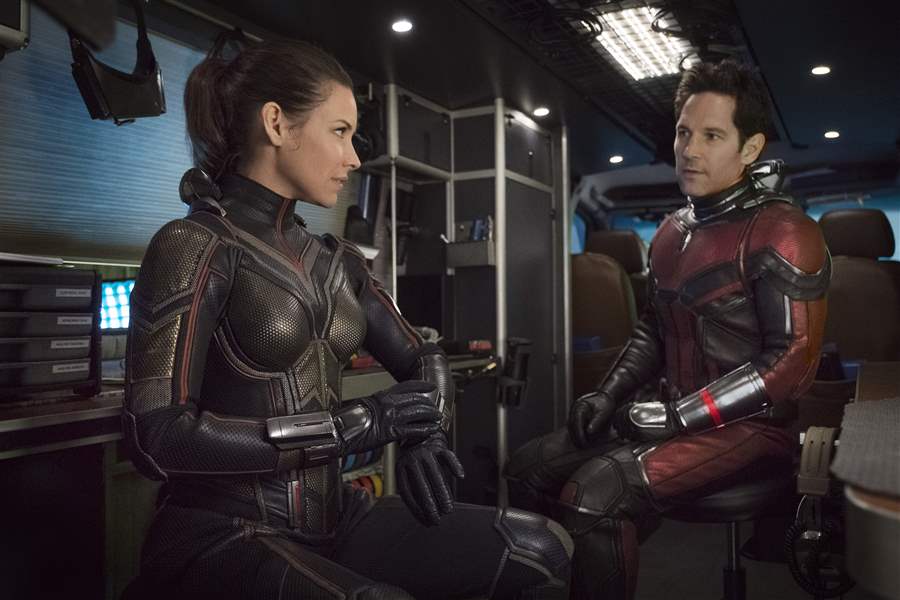
'Ant-Man and the Wasp' superior to the original
7/5/2018
Evangeline Lilly and Paul Rudd in a scene from "Ant-Man and the Wasp."
ASSOCIATED PRESS
Ant-Man in 2015 was a warm-up for its star Paul Rudd and for Marvel Studios.
The boyishly handsome comic-actor acclimated to being a cog in the well-oiled Marvel Cinematic Universe machine, playing thief-turned superhero Scott Lang, whose supersuit allows him to shrink to molecular size or expand into a giant.
And the studio eased into the expansion of its superhero franchise through second-tier comic books like Ant-Man.
Even as a safe investment, Ant-Man still earned more than $500 million worldwide. Which is why its superior sequel, Ant-Man and the Wasp, can afford to take more chances than its predecessor, including a less generic but more sympathetic villain, and a main mission that's not about saving the world, but a lost superhero.
Ant-Man and the Wasp picks up with the repercussions of Ant-Man’s important cameo in 2016's Captain America: Civil War, in which Scott fought alongside the fugitive Captain America and his team, who were against superheroes being forced to register with the government as super weapons.
Scott is now under yearlong house arrest and is never to become Ant-Man again. Not that he misses it. He is busy enough with a start-up security business he owns and runs with friend and fellow ex-con Luis (Michael Peña), and being a father to his young daughter, Cassie (Abby Ryder Fortson).
Ant-Man and the Wasp
Directed by Peyton Reed. Screenplay by Chris McKenna, Erik Sommers, Paul Rudd, Andrew Barrer, and Gabriel Ferrari. A Marvel release playing at Franklin Park, Fallen Timbers, Levis Commons, Bowling Green, Mall of Monroe, and Sundance Kid Drive-in. Rated PG-13 for some sci-fi action violence. Running time: 118 minutes.
Critic's rating: ★★★★
Cast: Paul Rudd, Evangeline Lilly, and Michael Pena.
He even got rid of the suit, which does not sit well with Hank Pym (Michael Douglas), the original Ant-Man, who recruited Scott as his replacement. After the divisive Civil War, Hank and his daughter, Hope Van Dyne (Evangeline Lilly), aka the Wasp, split with Scott and become fugitives themselves.
But they reconnect after Scott's vivid dream about Janet Van Dyne (Michelle Pfeiffer), Hank’s wife and Hope’s mother, who shrunk to sub-molecular level, what’s called the “Quantum Realm,” to stop a nuclear missile decades ago and never returned. They want to bring her back and they need Scott to do it.
Everything seems to be going their way until a mysterious entity known as the Ghost (Hannah John-Kamen), who can walk through solid objects and phase in and out of reality, making it difficult for our heroes to land a punch, shows up to steal the high-tech device they need to rescue Janet and that she needs to avoid a similar fate.
In Ant-Man, the hero’s change in size was a CGI novelty, with his point of view used as much for comic effect as it was to impress audiences desensitized to the impossible made possible through digital artistry.
Ant-Man and the Wasp, though, expands and mostly improves upon everything the original film did.
Now that two heroes have the same power, for example, and the ability to transmute the size of other objects such as cars and buildings, returning director Peyton Reed is keen to explore the dramatic possibilities of big-to-small and small-to-big, along with those variations of the original’s size-changing gags. And it mostly works.
A car chase through the streets of San Francisco, a nod like so many others to the famous Bullitt sequence, is given new life, or at least a new perspective, when one of the vehicles shrinks to the size of a Matchbox car in less than a second, and just as quickly returns to normal.
Or when Scott’s suit malfunctions, as causes him to change shape, awkwardly, while on a covert mission to his daughter’s school.
The film also benefits from Rudd’s time in the role, as the actor finds that space for irreverent and often arrested development-style of humor and the need for the character to grow up. Lilly also benefits from this second act, with a character that does more than advise, but takes action and kicks butt. (In ways that Scott admires and envies.) But the most interesting character turn is to Hank, who must come to terms with his personal failures and the resulting damage to others. Douglas, like Rudd and Lilly, is more at ease in this universe now that the rules have been established and Part 2 allows for expansion and character development.
TRAILER: Ant-Man and the Wasp
Peña is still used as comic relief, while Judy Greer as Scott's ex-wife, Maggie, and Bobby Cannavale as her cop husband are around just long enough for you to realize how repetitious their characters have become.
She asks lots of questions, he gives out lots of hugs.
Laurence Fishburne is also in the film, cast in the role of Dr. Bill Foster, a former colleague of Hank’s. Theirs is a history of good and bad. And without giving anything away, Reed and the film’s screenwriting team (five are given credit, including Rudd) explore duality as more than being big or small.
The race to save Janet is also rather effective, even if the last act isn’t really that. As an end credits scene reminds us, the Marvel Cinematic Universe is one interconnected story that is yet to be concluded — and probably never will be, so long as these movies continue to make billions of dollars.
Contact Kirk Baird at: kbaird@theblade.com or 419-724-6734.